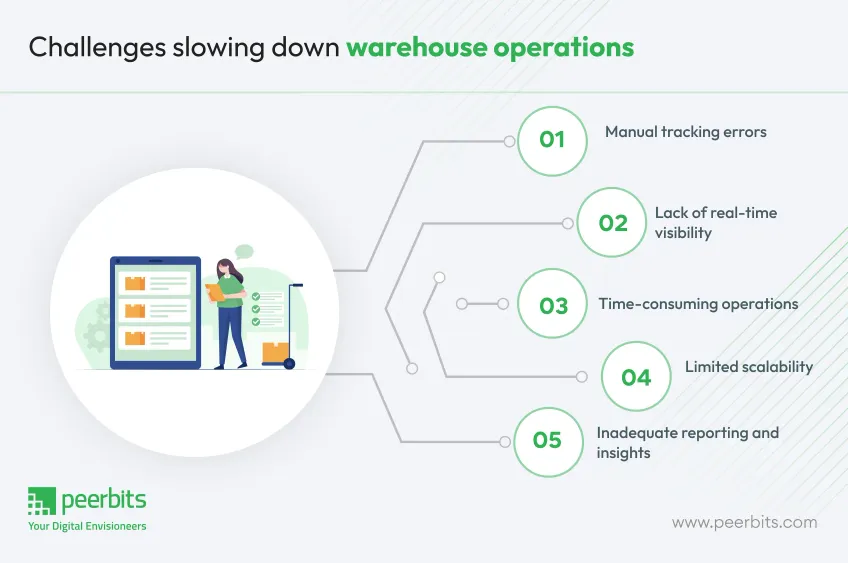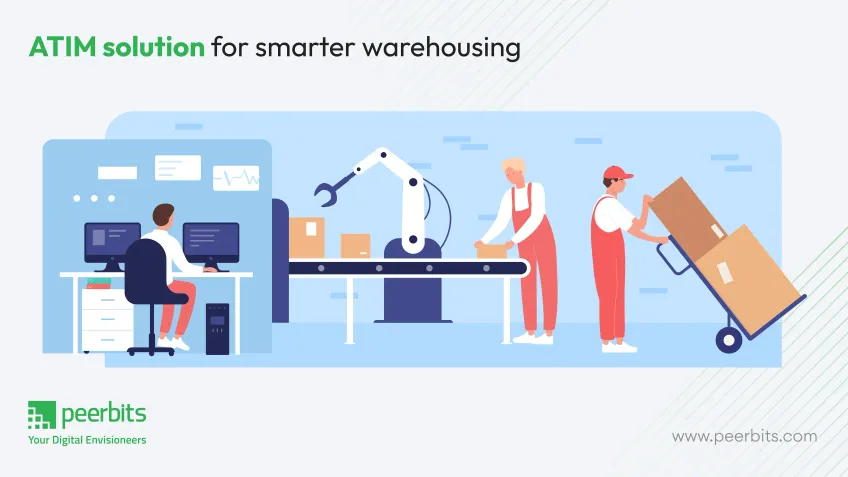Efficient inventory management is the backbone of a successful warehouse. The constant demand for faster operations, reduced errors, and cost savings has led businesses to adopt advanced technologies like warehouse inventory management systems.
These systems go beyond traditional methods, offering automation, accuracy, and real-time data insights to streamline warehouse processes.
Among these innovations, RFID warehouse management solutions stand out for their ability to transform how inventory is tracked, monitored, and managed.
Unlike conventional barcode systems, RFID technology provides strong infrastructure that helps businesses in maintaining accurate inventory levels and optimize their supply chains efficiently.
This blog covers the working of a warehouse inventory management system, focusing on RFID technology, its architecture, and its benefits for inventory and logistics.
But many get confused between RFID & barcodes as they are most commonly used in warehouses, let's check what's the difference between them first!
Difference between RFID & Barcode
When it comes to inventory management, RFID and barcode systems are two of the most commonly used technologies. Each offers unique features and benefits, but they cater to different operational needs. Below is a comparison to help you understand their differences and applications.
| Feature | Barcode system | RFID inventory system |
|---|---|---|
| Technology | Optical scanning of printed barcodes | Radio waves for communication between tags and readers |
| Line-of-sight requirement | Requires direct line-of-sight for scanning | No direct line-of-sight needed |
| Scanning method | Single item at a time | Bulk scanning of multiple items simultaneously |
| Data capacity | Limited to basic information | Can store extensive product details |
| Durability | Prone to wear and tear | Durable and suitable for harsh environments |
| Cost | Lower initial cost | Higher initial cost but long-term savings |
| Efficiency | Slower processes due to manual scanning | Faster processes with automated scanning |
| Applications | Ideal for small-scale or low-budget operations | Best suited for large-scale warehouses and logistics |
This table provides a clear perspective on how RFID technology outshines traditional barcode systems for complex inventory needs. As modern warehouses lean towards automation and accuracy, RFID warehouse management systems are emerging as the go-to solution for efficient inventory tracking.
Common challenges in traditional inventory management
Before diving into RFID solutions, it's essential to understand the issues faced by traditional inventory systems. Many warehouses still rely on outdated practices that struggle to keep up with modern demands, such as:

1. Manual tracking errors
Manual processes, such as handwritten records or manual barcode scanning, often lead to mistakes. These errors can cause discrepancies in inventory levels, leading to overstocking or stockouts.
2. Lack of real-time visibility
Traditional systems fail to provide real-time data, making it challenging to track inventory movements or predict supply chain bottlenecks.
3. Time-consuming operations
Scanning items one at a time or manually reconciling records slows down operations, especially in high-volume warehouses.
4. Limited scalability
As businesses grow, outdated systems often struggle to handle larger inventories or increased operational complexity.
5. Inadequate reporting and insights
Without detailed and accurate data, it becomes difficult to analyze trends or make informed decisions.
Addressing these challenges is why many businesses are turning to RFID inventory management systems. By automating processes and improving data accuracy, these systems offer a practical solution to modern warehousing needs.
How RFID technology works?
RFID technology is transforming the landscape of inventory management by enabling businesses to track and manage their products efficiently. In this section, we'll break down the basics of RFID technology, including the types of RFID tags and readers used in inventory systems.
Basics of RFID technology in inventory management
RFID (Radio Frequency Identification) uses radio waves to transmit data between an RFID tag and a reader, allowing businesses to track inventory in real-time.
RFID technology automates the process of identifying and managing products, which reduces human error and enhances the speed and accuracy of operations within a warehouse inventory management system.
In a typical RFID setup, tags are attached to products or assets, and readers are placed at strategic locations to capture data from these tags.
This system facilitates continuous tracking of items as they move throughout a warehouse or supply chain, offering detailed insights into inventory levels, product location, and movement.
Types of RFID tags
RFID tags come in two main types: passive and active. Both serve the same purpose of identifying items, but they differ in how they operate and are used.
1. Passive tags
These tags do not have their own power source. Instead, they rely on the energy emitted by an RFID reader to power up and transmit information.
- Advantages: Passive tags are cost-effective and lightweight, making them ideal for large-scale deployments in RFID inventory tracking systems. They can be used on various inventory items without worrying about battery life.
- Disadvantages: Their range is limited, typically up to a few meters. They are also slower in comparison to active tags.
2. Active tags
Active RFID tags are equipped with a battery that allows them to emit radio signals continuously or when prompted by a reader.
- Advantages: These tags have a longer range (up to 100 meters) and can store more data, making them suitable for tracking high-value assets with RFID or large items in the supply chain.
- Disadvantages: They are more expensive than passive tags and require periodic battery replacement.
Types of RFID readers
RFID readers come in two main types: fixed readers and handheld readers. Both are used to capture data from RFID tags, but they differ in their functionality and application within RFID warehouse management systems.
Fixed readers
These readers are permanently installed in a specific location, such as on entry or exit points within a warehouse. They continuously monitor the movement of goods and assets as they pass by, providing real-time data updates to the inventory management system.
Applications: Fixed readers are commonly used for monitoring inventory in larger warehouses, distribution centers, and logistics hubs where goods are consistently moving.
Handheld readers
Handheld RFID readers are portable devices that allow workers to manually scan RFID tags anywhere within the warehouse. They are ideal for spot checks, stocktaking, or when scanning specific items that may not pass through fixed reader zones.
Applications: Handheld readers are useful for smaller-scale operations or tasks that require flexibility, such as tracking items stored in remote or hard-to-reach locations.

Why RFID technology is effective for inventory management?
RFID technology offers significant advantages over traditional barcode systems:
- Real-time data: RFID provides instant updates on inventory levels, allowing businesses to make quick, data-driven decisions.
- Improved accuracy: Since RFID eliminates manual scanning, it reduces human errors, ensuring that inventory data is precise and up-to-date.
- Increased efficiency: RFID allows bulk scanning of items without direct line of sight, speeding up processes like stocktaking and order fulfillment.
- Scalability: RFID systems can handle large volumes of items, making them ideal for expanding businesses or large-scale warehouses.
RFID inventory management systems offer a higher level of automation, accuracy, and efficiency compared to traditional barcode-based systems, making them a key component of modern warehouse operations.
Communication protocols and technology stack
Efficient communication forms the backbone of any RFID inventory tracking system, ensuring smooth interactions between components. Below, we explore the key communication protocols and the technology stack behind RFID systems.
Key communication protocols
RFID systems use specific protocols to enable communication between tags and readers. The two primary protocols are:
| Protocol | How it works | When it’s used |
|---|---|---|
| TTF protocol | The tag sends data first when it comes within the reader’s range. | High-volume environments needing quick identification. |
| ITF protocol | The reader activates the tag by sending a signal before communication begins. | Controlled settings where selective tag interaction is needed. |
Technology stack for RFID-based systems
Developing an effective rfid inventory management system requires a robust combination of hardware, software, and communication infrastructure. The typical components include:
1. RFID hardware:
- Tags: These are attached to inventory items and come in two types: passive (cost-effective and powered by the reader's signal) and active (self-powered, suitable for high-value assets).
- Readers: Devices that capture data from RFID tags. They can be fixed for stationary use or handheld for mobile applications.
2. Middleware:
Software that processes raw RFID data, filters out duplicates, and converts it into actionable insights. Middleware acts as a bridge between RFID readers and backend systems, enabling real-time operations.
3. Database management system:
A centralized system that stores and organizes inventory data. Popular solutions include MySQL, PostgreSQL, or cloud-based databases, offering scalability and reliability.
4. Backend systems:
These integrate with RFID data for inventory tracking, reporting, and analytics. Examples include ERP systems or custom-built warehouse management system built by logistic software development companies.
5. Communication network:
Infrastructure such as Wi-Fi, Ethernet, or cellular networks connects RFID readers to middleware and backend systems, ensuring smooth data flow and synchronization.
6. User interfaces:
Dashboards or mobile applications provide real-time insights into inventory status, allowing users to track stock levels, analyze trends, and generate reports with ease.
Combining these protocols and technologies creates a strong rfid warehouse management system, ensuring accurate inventory tracking and improved operational efficiency.
Designing an RFID system: Key considerations
Developing an effective RFID inventory management system involves careful planning and decision-making. The design process must account for operational requirements, technological capabilities, and environmental factors to ensure reliable performance.
Below are the key considerations for designing such a system.
Tag list requirements and reservation system design
An RFID system’s success heavily depends on how tags are organized and reserved within the inventory system.
Tag list requirements:
Creating a well-defined tag list is essential for accurate inventory tracking. Each item in the inventory should have a unique tag ID to prevent duplication or misreads. Tag encoding must align with inventory categories, such as product type, batch number, or expiration date.
Reservation system design:
To prevent tag ID conflicts, a reservation system is necessary. It assigns a predefined range of tag IDs for each category or operation. This ensures smooth integration of new inventory items into the rfid warehouse management system without overlapping existing IDs.
Factors affecting tag and reader selection
Choosing the right RFID tags and readers significantly impacts system efficiency and accuracy. Several factors come into play:
Tag type and material:
- Passive tags: Cost-effective and suitable for high-volume, low-cost items. These tags are powered by the reader's signal and work well in environments with short to medium read ranges.
- Active tags: Self-powered and ideal for high-value or large items requiring longer read ranges and better reliability.
- Material compatibility: Tags should be compatible with the surface material of items, as metal or liquid surfaces can interfere with signal transmission.
Reader type:
- Fixed readers: Best for stationary checkpoints, such as warehouse entrances or conveyor belts, offering high precision and automation.
- Handheld readers: Ideal for mobile operations, inventory audits, and areas where fixed readers aren’t feasible.
Read range:
Tags and readers must be chosen based on the required distance for data capture. Longer read ranges are essential for large warehouses, while shorter ranges suit compact spaces.
Environment and durability:
- Environmental factors such as temperature, humidity, and potential exposure to chemicals should guide tag and reader selection.
- Rugged tags and readers are necessary for harsh conditions to ensure consistent performance.
Addressing these key considerations helps businesses create an optimized RFID inventory system that aligns with their operational needs, ensuring accurate tracking and smooth integration into their workflows.
ATIM solution: Asset Tracking and Inventory Management
The Asset Tracking and Inventory Management (ATIM) solution helps warehouses modernize operations by using RFID technology for accurate tracking and smooth workflows. Below are its features, components, and the impact it has on warehouse processes.

Features and components of the ATIM solution
The ATIM solution combines hardware, software, and real-time data processing. Its key elements include:
- Dashboard interface: A centralized platform that provides live updates on inventory status, asset locations, and generates detailed reports.
- RFID tags and scanners: Tags attached to items and strategically placed scanners enable precise identification and location tracking.
- Alert system: Automated notifications for stock shortages, misplaced items, or unauthorized movements reduce operational mishaps.
- Data insights: Tools to analyze inventory patterns assist in better planning and stocking strategies.
- Cloud connectivity: Ensures inventory data remains accessible across multiple locations, offering a unified management experience.
Role of ATIM in warehouse efficiency and accuracy
The ATIM solution transforms warehouse operations in multiple ways:
- Reducing human errors: Automated systems replace manual tracking, cutting down inaccuracies.
- Speeding up audits: RFID technology simplifies audits by instantly identifying items and updating records.
- Improving inventory visibility: Real-time tracking provides clear and instant knowledge of inventory levels and asset movement.
- Better resource utilization: Insights from tracking systems help optimize resource distribution, saving time and labor.
- Supporting better decisions: Analyzed data provides actionable insights for storage, procurement, and distribution management.
An RFID inventory management system like ATIM enhances warehouse capabilities by integrating technology into asset and inventory management. This leads to improved reliability, cost savings, and better customer service outcomes.
Read more: How does IoT impact the transport and logistics industry?
Applications of RFID technology in warehousing
RFID technology has revolutionized warehouse management by providing accurate tracking and data-driven insights. Here’s how it is applied in various warehousing processes:
1. Real-time product tracking in the supply chain
RFID systems offer unparalleled precision in tracking products throughout the supply chain. By tagging items with RFID labels, warehouses can monitor their movement in real time, ensuring that products reach the right destinations on schedule.
This enhances coordination across suppliers, distributors, and retailers, helping prevent delays or misplacements.
2. Monitoring inventory levels and stock movement
With an rfid inventory management system, warehouses can automatically update inventory data without manual intervention. The technology continuously tracks stock levels and provides instant updates when items are added or removed from storage.
This reduces overstocking or stockouts and simplifies restocking decisions.
3. Improving security and traceability of materials
RFID enhances security by providing a reliable method to track assets and prevent unauthorized access or theft. The system creates a detailed audit trail for every item, improving traceability and accountability.
This is especially useful for high-value or regulated goods that require stringent tracking measures.
Implementing an rfid inventory tracking system enables warehouses to achieve better operational accuracy and maintain tighter control over assets and stock. This improves overall efficiency and supports smooth supply chain operations.
Benefits of implementing a smart warehouse management system
Adopting a warehouse inventory management system can transform warehouse operations by automating tasks and improving accuracy. Below are the key advantages:
1. Streamlined processes and operational efficiency
A smart warehouse management system simplifies day-to-day operations by automating repetitive tasks like inventory updates, order processing, and product tracking. This reduces manual efforts, making workflows faster and more organized.
2. Better collaboration with suppliers and customers
Real-time data sharing facilitates better communication with suppliers and customers. Accurate inventory levels and delivery updates ensure smoother transactions, boosting overall satisfaction for all parties involved.
3. Real-time inventory tracking and balancing
With rfid inventory management, warehouses can track items in real time, ensuring stock is always updated. This helps maintain the right balance of inventory, preventing shortages or excesses.
4. Reduction in operational costs
Automation reduces labor-intensive tasks and minimizes errors, cutting down on operational expenses. The efficiency gained through a warehouse management system in logistics app development translates into cost savings for the entire supply chain.
5. Enhanced transparency in reporting and auditing
RFID systems enable accurate data collection, improving transparency in inventory reporting. This simplifies audits by providing clear and accessible records of stock movement and storage.
6. Improved security measures
By using RFID tags and readers, warehouses can monitor asset movement and identify unauthorized activities. This helps protect high-value goods and minimizes theft or losses.
7. Internal automation advantages
Automation tools, integrated with RFID systems, enable faster order processing, stock replenishment, and shipping. These enhancements lead to reduced bottlenecks and quicker turnaround times.
8. Continuous workflow improvements
Smart systems use analytics to identify inefficiencies and suggest workflow optimizations. This ensures ongoing improvements and lets warehouses stay agile and responsive to changing demands.
Implementing a rfid warehouse management system drives operational excellence, enhances accuracy, and supports a more reliable supply chain. These benefits make it an essential tool for modern warehouse operations.
Measuring the Return on Investment (RoI)
Adopting an RFID warehouse management system can bring significant improvements to warehouse operations. To assess its value, it's essential to understand both the costs and the long-term benefits it provides.
Cost-benefit analysis of RFID systems
Implementing RFID technology involves initial costs like hardware (tags and readers), software integration, and employee training. Over time, these expenses are offset by:
- Lower labor costs due to automation of inventory-related tasks.
- Accurate inventory tracking, reducing losses from misplaced or miscounted stock.
- Faster operations, leading to improved customer service and order fulfillment.
Analyzing these factors helps in understanding the financial benefits that RFID systems offer.
Examples of successful implementations
-
Walmart: The retail giant uses RFID technology extensively to monitor inventory levels. This system has reduced stockouts and improved product availability on shelves, translating into millions of dollars saved annually.
-
City Furniture: This furniture retailer streamlined its inventory management process by using RFID for cycle counting. The result was greater inventory accuracy and better resource management.
These real-life examples highlight the measurable impact of RFID systems on efficiency and cost reduction.
Long-term savings and operational gains
Over time, RFID systems deliver value by:
- Reducing excess inventory, which cuts down storage costs.
- Preventing theft and loss through better tracking and security.
- Enhancing decision-making with real-time data on inventory movement.
These factors contribute to sustained financial benefits, making RFID systems a smart investment for modern warehouse operations.
Conclusion:
Implementing a warehouse inventory management system powered by RFID technology brings a significant shift for businesses aiming to improve operational precision and efficiency. With RFID solutions, warehouses gain better inventory control, reduce inaccuracies, and optimize their workflows.
From understanding the mechanics of RFID inventory systems to exploring their uses in real-time tracking and security improvements, the advantages are undeniable.
For industries like logistics, retail, and manufacturing, adopting a warehouse management system in logistics is a strategic move toward long-term efficiency, improved customer satisfaction, and financial savings.
Business can prepare for sustained growth and success in a dynamic market by grabbing advances solutions like RFID.

FAQ's
RFID systems can scan multiple tags simultaneously without needing direct line-of-sight, making them faster and more efficient than barcodes.
Yes, certain types of RFID tags, like active and passive tags with durable materials, can be reused after reprogramming. However, the reusability depends on the application and the tag's condition after use.
Industries like logistics, retail, healthcare, and manufacturing can gain substantial benefits from RFID systems. They improve stock accuracy, reduce theft, and enhance overall process efficiency.
Regular maintenance involves checking reader functionality, ensuring the proper positioning of antennas, and replacing damaged or worn-out tags. Additionally, software updates are crucial to maintain compatibility and performance.
Yes, modern RFID solutions are designed to integrate seamlessly with popular warehouse management software, providing real-time inventory updates and analytics to improve decision-making.
Absolutely. RFID solutions are available in various configurations and price points, making them suitable for businesses of all sizes. Smaller warehouses can start with basic systems and scale up as their needs grow.
Materials like metal and liquids can interfere with RFID signals. However, specialized tags and readers are available to overcome these challenges in specific environments.








